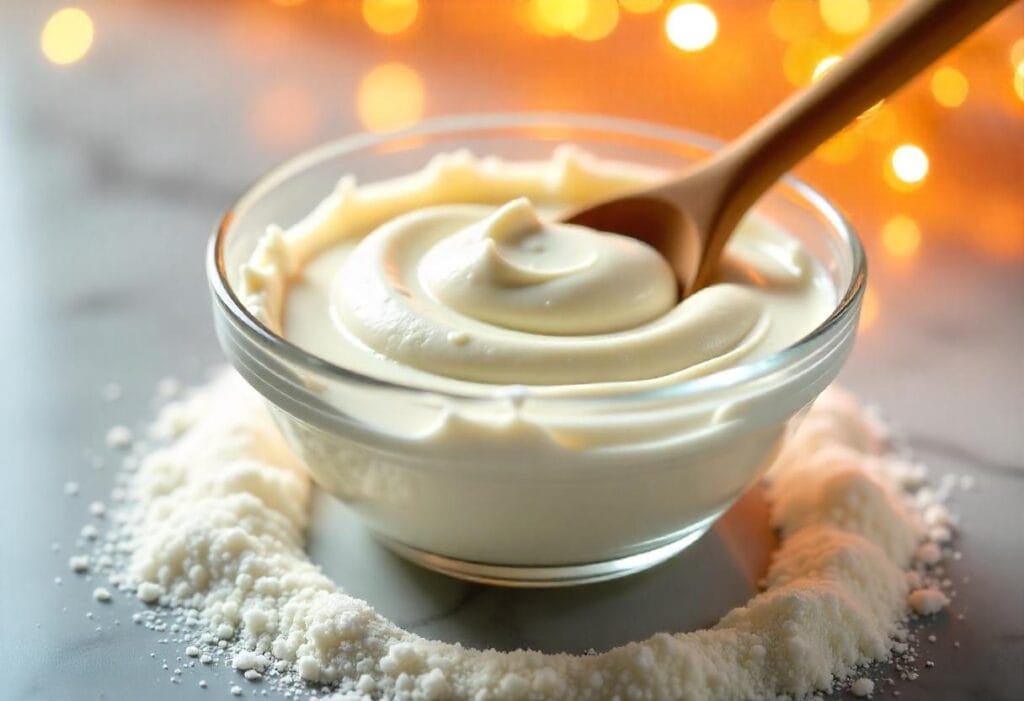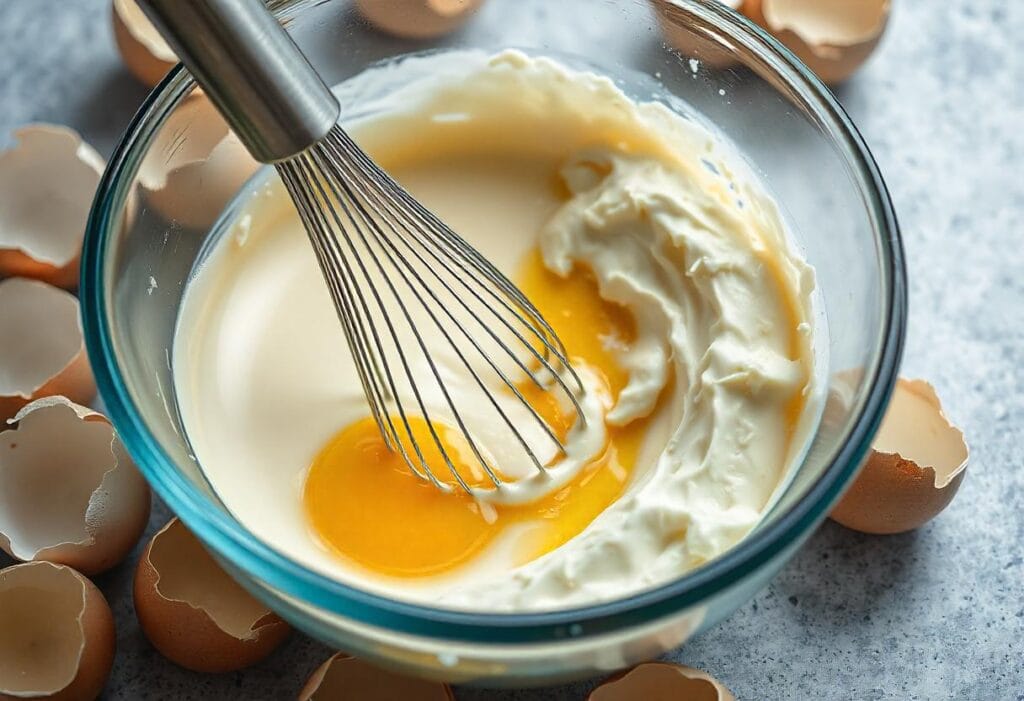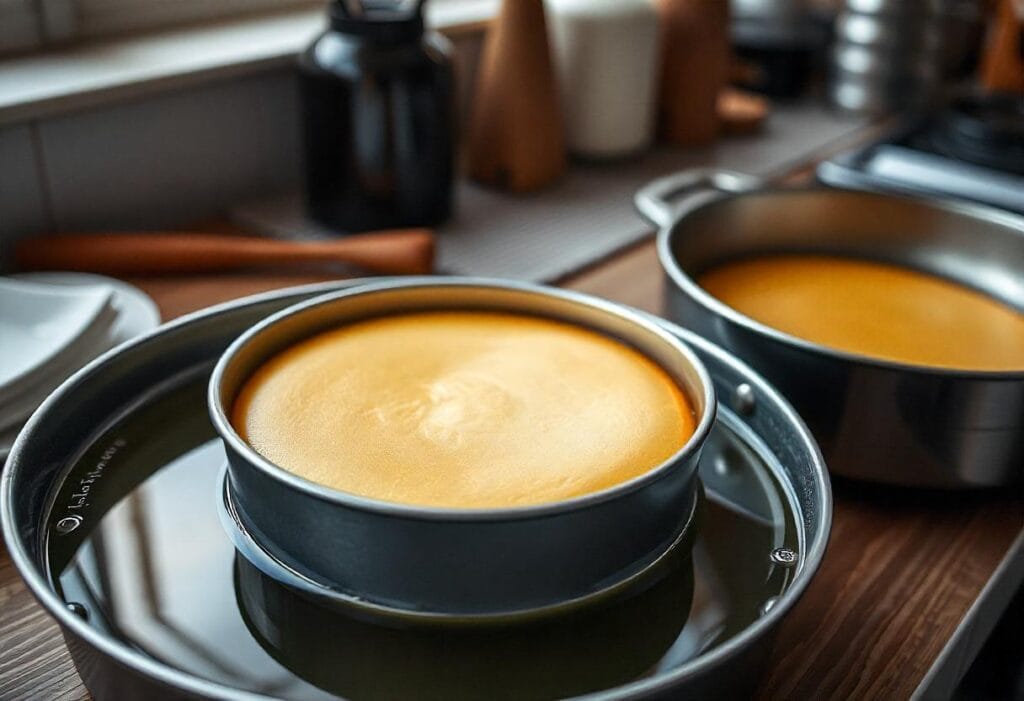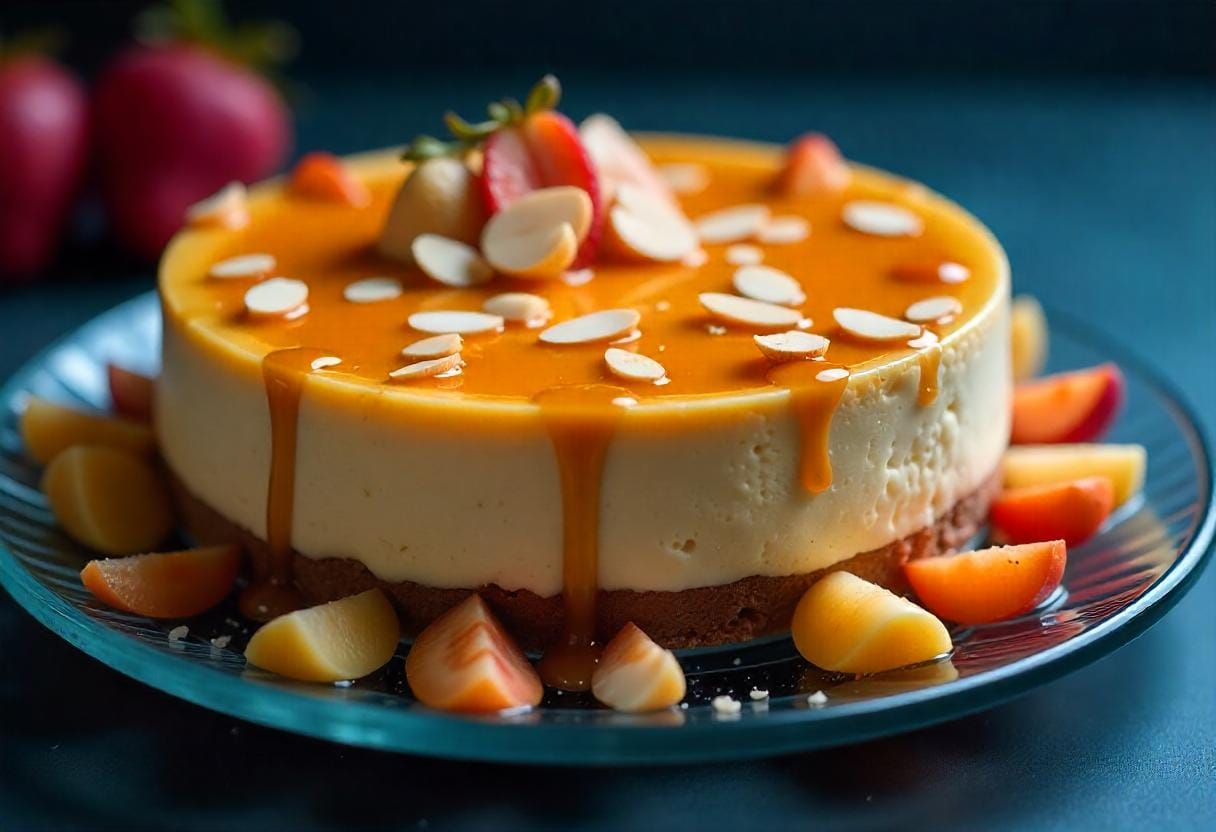Table of Contents
What is the thickening agent in cheesecake If you’ve ever wondered how cheesecake achieves its creamy yet firm texture, the secret lies in the thickening agents. Whether it’s eggs, gelatin, or cream cheese, these ingredients ensure your cheesecake sets perfectly. In this guide, we’ll explore different thickening agents and how they impact texture and consistency
Understanding Cheesecake: The Science Behind Its Texture
To truly understand what is the thickening agent in cheesecake, you need to explore how ingredients like cream cheese and eggs create structure
The thickening agent is the hero behind the scenes, ensuring your cheesecake isn’t a runny mess but a luscious masterpiece. Think of it as the glue that binds all the delicious components—cream cheese, sugar, eggs, and flavorings—into a harmonious whole.
« The magic of cheesecake isn’t just in its taste but in how it feels on your fork—a blend of firmness and melt-in-your-mouth softness. »
The Role of Thickening Agents in Cheesecake
Why Is a Thickening Agent Necessary?
One of the most fascinating aspects of baking is learning what is the thickening agent in cheesecake and how it influences texture
It also helps balance the dessert’s structural integrity and creaminess, giving each bite a velvety feel.
How Does It Impact Texture and Consistency?
The choice of thickening agent directly impacts your cheesecake’s final texture. A custardy, dense cheesecake relies on eggs, while a light and jiggly no-bake cheesecake might use gelatin or whipped cream. Each ingredient brings its own unique charm to the table.
« Texture isn’t just a detail in cheesecake—it’s the entire experience. The right thickening agent makes all the difference. »
Common Thickening Agents Used in Cheesecake
When asking what is the thickening agent in cheesecake, the answer often depends on the type of cheesecake—baked or no-bake
Cream Cheese: The Essential Ingredient
No cheesecake would be complete without cream cheese. It’s the backbone of the dessert, providing richness and a subtle tanginess. When mixed with sugar and eggs, cream cheese sets into a creamy, sliceable base.
| Nutrient (Per 1 oz of Cream Cheese) | Amount |
|---|---|
| Calories | 99 kcal |
| Protein | 2 g |
| Fat | 10 g |
| Carbohydrates | 1 g |
« Cream cheese is like the lead actor in a cheesecake play—it’s impossible to imagine the dessert without it! »
Eggs: Nature’s Natural Thickener
Eggs are the unsung heroes of baked cheesecake. When heated, their proteins coagulate, creating structure and stability. They also add richness and depth to the flavor.
- Pro Tip: Overmixing eggs can introduce air into the batter, leading to cracks. Be gentle!
Gelatin: The Secret to No-Bake Cheesecakes
For those creamy, chilled no-bake cheesecakes, gelatin takes center stage. This protein-based thickener sets the cheesecake without the need for heat, giving it a light yet firm texture.
- Pro Tip: Dissolve gelatin properly in warm liquid before incorporating it into your batter to avoid clumps.
Cornstarch and Flour: For Stability and Structure
Cornstarch and flour are often added to baked cheesecakes for extra stability. These starches absorb moisture, preventing the custard from becoming too soft or runny.
« Adding a touch of starch is like giving your cheesecake a safety net—it ensures perfection every time. »

Comparing Thickening Agents: Pros and Cons
Each thickening agent brings its own strengths and weaknesses to the table. Here’s how they compare:
| Thickening Agent | Pros | Cons |
|---|---|---|
| Cream Cheese | Rich flavor, creamy texture | High in fat, calorie-dense |
| Eggs | Natural, enhances structure | Can crack if overbaked |
| Gelatin | Great for no-bake cheesecakes | Requires precise handling |
| Cornstarch/Flour | Adds stability | Can affect flavor if overused |
How to Choose the Right Thickening Agent for Your Cheesecake
The best thickening agent depends on the type of cheesecake you want to make.
Factors to Consider: Baking vs. No-Baking
If you’re making a baked cheesecake, eggs are usually your go-to option for their ability to set at high temperatures. For no-bake cheesecakes, gelatin or cream cheese works wonders for a chilled, creamy finish.
Flavor and Texture Preferences
Do you want your cheesecake to be dense and rich or light and airy? Eggs and cream cheese create a classic texture, while gelatin offers a more delicate consistency.
« The beauty of cheesecake is in its versatility—choose the thickening agent that matches your vision! »
Common Problems with Cheesecake Texture
Even with the best thickening agents, things can go wrong. Here’s how to troubleshoot:
Why Did My Cheesecake Crack?
Cracks often happen when the batter is overmixed or baked at too high a temperature. To prevent this:
- Bake your cheesecake in a water bath for even heat distribution.
- Let it cool gradually in the oven with the door slightly open.
« Think of cracks as the cheesecake’s way of showing its personality—it’s still delicious, just a bit rustic! »
How to Fix a Runny Cheesecake
If your cheesecake doesn’t set properly, it might be due to:
- Insufficient thickening agent.
- Undercooking the custard.
To fix this, consider refrigerating the cheesecake longer or serving it as a parfait with layers of crumbled cookies and whipped cream.
Avoiding Over- or Under-Thickened Cheesecake
Striking the right balance with thickening agents is key. Measure ingredients precisely and follow your recipe closely to ensure the perfect consistency.
Step-by-Step: Using Thickening Agents in Cheesecake
Mastering the use of thickening agents in cheesecake requires attention to detail and a bit of patience. Here’s a detailed breakdown of how to incorporate each type of thickening agent.
Incorporating Eggs for Baked Cheesecakes
Eggs are the backbone of traditional baked cheesecakes. Their proteins coagulate when heated, creating a smooth, firm texture.
- Prepare the Base: Beat cream cheese and sugar until smooth.
- Add Eggs Gradually: Add eggs one at a time, mixing just until combined. Avoid overmixing, as it can introduce air bubbles.
- Bake Gently: Use a water bath to maintain consistent heat and prevent the edges from overcooking.
« Eggs are like the architects of baked cheesecakes—they build structure and stability while keeping everything creamy. »

Adding Gelatin for No-Bake Cheesecakes
Gelatin is your go-to for no-bake cheesecakes, offering a firm but light texture.
- Dissolve Gelatin: Sprinkle powdered gelatin over a small amount of cold water and let it bloom for a few minutes.
- Heat and Mix: Gently heat the gelatin until fully dissolved, then mix it into the cheesecake batter.
- Chill to Set: Pour the batter into your crust and refrigerate for at least 4–6 hours.
- Pro Tip: To avoid lumps, make sure the gelatin mixture is slightly warm when incorporating it into the batter.
When to Use Flour or Cornstarch
Flour and cornstarch are often added to baked cheesecakes for added stability.
- How to Use: Add 1–2 tablespoons of cornstarch or flour to the cream cheese mixture. Mix until smooth.
- Best Practices: Avoid adding too much, as it can create a gummy texture or alter the flavor.
« A little bit of starch is like a secret weapon—it’s subtle but ensures your cheesecake stays intact. »
Tips for Achieving Perfect Cheesecake Consistency
Whether you’re making a classic baked cheesecake or an easy no-bake version, these tips will help you achieve the perfect texture every time.
Balancing Ingredients for Stability
The ratio of cream cheese, sugar, eggs, and other thickeners is crucial. Too much of one ingredient can throw off the balance. Follow recipes closely and measure ingredients accurately.
Preventing Overmixing or Undermixing
- Overmixing: Introduces air into the batter, which can cause cracks or an uneven texture.
- Undermixing: Leaves lumps of cream cheese, leading to inconsistent texture.
Mix until smooth but stop as soon as everything is combined.
Ideal Baking and Cooling Techniques
Baking and cooling are as important as the thickening agents themselves.
- Water Bath: Prevents the edges from overcooking and ensures an even texture.
- Gradual Cooling: Cool the cheesecake in the oven with the door slightly open to prevent cracks from forming.
« Patience is key with cheesecake—rushing the cooling process is a recipe for disappointment. »

Exploring the Origins of Cheesecake and Its Evolution
Cheesecake’s creamy allure has captivated taste buds for centuries. While modern recipes rely on cream cheese and eggs, the dessert’s history offers fascinating insights into its evolution.
Ancient Beginnings
The earliest recorded cheesecakes date back to ancient Greece, where they were served to athletes during the first Olympic Games in 776 BCE. These early versions used simple ingredients like cheese, honey, and wheat flour, baked into a humble yet satisfying treat.
« Who knew that cheesecake started as fuel for athletes? Maybe that explains why it’s so energizing! »
From Europe to America
Cheesecake traveled across Europe, where cultures adapted it using local ingredients. In Italy, ricotta cheese became the star, while Germany favored quark. By the 18th century, cheesecakes crossed the Atlantic to America, where cream cheese was invented and became the staple ingredient we know today.
« Cheesecake’s journey through time is a testament to its universal appeal—no matter the era or location, people love its creamy texture. »
The Science of Thickening Agents in Cheesecake
Why do thickening agents work so well in cheesecake? The answer lies in the science of their interactions.
The Role of Protein
Eggs and cream cheese are rich in proteins, which coagulate when heated, creating a firm structure. This process, known as protein denaturation, transforms a liquid batter into a solid dessert.
The Role of Starch
Cornstarch and flour absorb moisture, helping to stabilize the batter. When heated, starch granules swell and thicken, preventing the custard from becoming too runny.
« Think of starch as the framework of your cheesecake—it holds everything together while letting the creamy flavors shine. »
Advanced Techniques for Perfect Cheesecake
Ready to elevate your cheesecake game? Here are some advanced tips and techniques:
Room Temperature Ingredients Are Key
Using room-temperature cream cheese, eggs, and other ingredients ensures a smoother batter. Cold ingredients can lead to lumps, which affect the texture of your cheesecake.
The Importance of Parchment Paper
Line the bottom of your springform pan with parchment paper for easy release. It prevents the crust from sticking, giving you clean, professional-looking slices.
« Small details like parchment paper can make a big difference in the final presentation of your cheesecake. »
Variations of Cheesecake from Around the World
While we often associate cheesecake with cream cheese and graham cracker crusts, other cultures have their own delightful interpretations of this beloved dessert.
Japanese Cotton Cheesecake
This airy version of cheesecake uses whipped egg whites to create a soufflé-like texture. It’s less sweet and incredibly light, perfect for those who prefer a subtle flavor profile.
German Käsekuchen
Made with quark cheese, this version is firmer and less creamy than American-style cheesecake. It often features a hint of lemon for a refreshing twist.
Italian Ricotta Cheesecake
Ricotta cheese gives Italian cheesecake a lighter, less dense texture. It’s often flavored with almond extract or lemon zest, making it a favorite for festive occasions.
« Every culture has its take on cheesecake, proving there’s more than one way to enjoy this timeless dessert. »
Creative Ways to Flavor Your Cheesecake
Cheesecake is a blank canvas for culinary creativity. Here are some exciting ways to infuse unique flavors into your dessert:
Swirls and Mix-Ins
- Fruit Swirls: Create a marble effect by swirling in raspberry, blueberry, or mango puree.
- Chocolate Chips: Fold mini chocolate chips into the batter for added texture.
Infused Creams
Steep cream with ingredients like lavender, chai spices, or coffee before incorporating it into your batter.
Seasonal Ingredients
- Pumpkin Spice: Add pumpkin puree and warm spices for a fall-inspired cheesecake.
- Peppermint: Crushed candy canes are perfect for a winter holiday twist.
« Flavored cheesecakes are like edible stories—each one tells a unique tale with every bite. »
The Art of Plating and Serving Cheesecake
Presentation matters, especially for a dessert as elegant as cheesecake. Here are some tips to wow your guests:
Garnishes and Toppings
- Fresh Berries: Add color and freshness with strawberries, raspberries, or blackberries.
- Whipped Cream: A dollop of freshly whipped cream adds a light, fluffy contrast.
- Drizzles: Use caramel, chocolate, or fruit syrups to create beautiful designs on the plate.
Cutting the Perfect Slice
To cut clean slices:
- Use a sharp knife dipped in hot water and wiped dry.
- Clean the knife between each slice for a polished look.
« Serving cheesecake should feel as luxurious as eating it—every detail counts! »
Troubleshooting Cheesecake Disasters
Even experienced bakers face challenges. Let’s explore more potential pitfalls and how to fix them:
Problem: Gummy or Overly Dense Cheesecake
Cause: Adding too much flour or cornstarch.
Solution: Stick to the recipe’s recommended amounts. A little starch goes a long way!
Problem: Soggy Crust
Cause: Water from the water bath leaks into the crust.
Solution: Wrap the bottom of your springform pan tightly in aluminum foil before baking. Alternatively, use a silicone pan guard.
« Remember, mistakes are part of the journey—every failed cheesecake teaches you something new. »
Hosting a Cheesecake Tasting Night
Want to share your love of cheesecake with friends? Host a tasting night featuring different flavors and textures!
The Setup
- Variety: Offer baked, no-bake, and international styles of cheesecake.
- Pairings: Provide coffee, tea, or dessert wine to complement the flavors.
- Decor: Use elegant platters and garnish each cheesecake slice with unique toppings.
« A cheesecake tasting night is the perfect blend of fun and flavor—a true treat for the senses. »
The Final Bite
Cheesecake is more than just a dessert—it’s a blend of art, science, and tradition. By understanding the role of thickening agents and experimenting with flavors, you can create cheesecakes that are as delicious as they are memorable.
So, whether you’re a novice or a seasoned baker, don’t be afraid to try new techniques, fix mistakes, and make the recipe your own. The best part of cheesecake isn’t just eating it—it’s the joy of crafting something special.
« When you bake a cheesecake, you’re not just making a dessert—you’re creating a masterpiece of flavor and texture. »
FAQs About Thickening Agents in Cheesecake
Many bakers ask, what is the thickening agent in cheesecake, and the answer lies in ingredients like cream cheese, eggs, or gelatin
Can I Make Cheesecake Without Eggs?
Yes! You can use alternatives like gelatin, cornstarch, or even cream cheese alone. For vegan cheesecakes, silken tofu or cashew cream can act as thickeners.
« Egg-free cheesecakes prove that creativity in the kitchen knows no bounds! »
What Is the Best Substitute for Gelatin?
If you prefer not to use gelatin, consider:
- Agar-Agar: A plant-based substitute that works similarly to gelatin.
- Pectin: Adds a subtle firmness, often used in fruit-based cheesecakes.
How Do I Know If I’ve Added Enough Thickening Agent?
Your batter should be smooth and thick but pourable. After baking or chilling, the cheesecake should hold its shape when sliced but feel creamy on the palate.
« The perfect cheesecake is all about balance—firm enough to slice, creamy enough to melt in your mouth. »
Conclusion: Mastering the Art of Cheesecake Texture
Thickening agents are the unsung heroes of cheesecake, turning a simple mixture of cream cheese, sugar, and eggs into a luxurious dessert. By understanding how each thickener works and choosing the right one for your recipe, you can create cheesecakes that are as stunning as they are delicious.
Whether you’re a fan of dense baked cheesecakes or light no-bake versions, the right thickening agent will elevate your dessert to perfection. So grab your ingredients, follow these tips, and get ready to wow your friends and family with every slice.
« With the perfect thickening agent, cheesecake isn’t just a dessert—it’s a work of art! »

